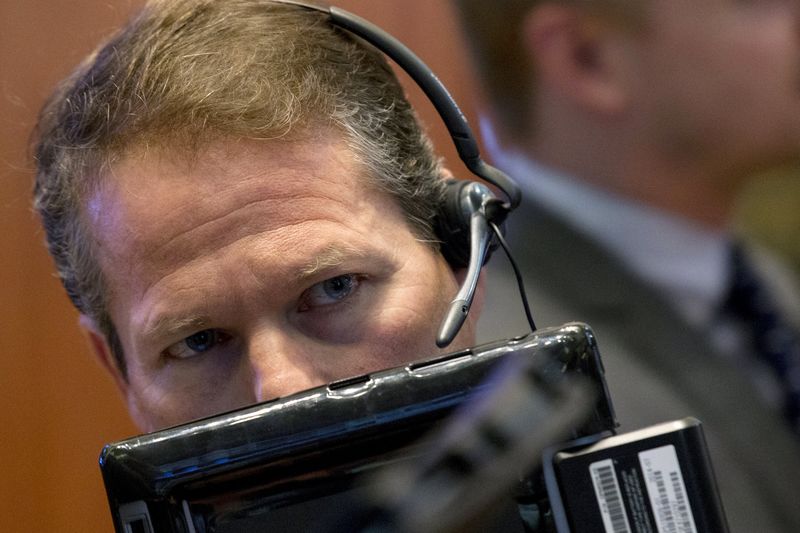* Trade war concerns grow as July 6 U.S. tariff deadline nears
* Shanghai stocks at 2-yr low, HK down 3 pct before edging up
* Chinese yuan slips past 6.7; recovers after reported intervention
* European shares, euro rise after German compromise on migration
* Wall Street set for another firmer session on tech
* Turkish lira falls as inflation rises to 14-yr highs (Changes quotes, updates prices throughout)
By Sujata Rao
LONDON, July 3 (Reuters) - World stocks rose on Tuesday, supported by gains in Europe and three straight days of tech-driven rises in the United States, even though markets across Asia and especially China remained in the grip of trade turbulence.
Wall Street was set for another firmer session as investors positioned for strong Silicon Valley earnings before the reporting season starts next week, while European shares also rose after a deal on settling a migration policy row that had threatened Germany's coalition government. a July 6 deadline is looming for Washington to impose tariffs on $34 billion worth of Chinese goods that Beijing has vowed to match with tariffs on U.S. products. President Donald Trump also threatened on Monday to "do something" if the United States was not better treated by the World Trade Organisation.
Prospects of a full-blown trade war and relentless yuan weakening CNY= -- it has fallen 5 percent in the past two weeks near 11-month lows -- reportedly forced China into intervention via state-run banks. central bank advisor was also quoted as saying authorities did not expect significant yuan depreciation. That helped the yuan reverse earlier losses to move back into positive territory for the day against the dollar, standing 0.3 percent firmer in offshore trade at 6.66 per dollar CNH= .
The gains filtered through to other Asian currencies, as well as the Australian dollar, considered a proxy for China risk, allowing it to edge off 1-1/2-year lows to the greenback AUD= .
However, forward markets anticipate the yuan will stay under pressure. It is seen trading around 6.7 per dollar in six months' time CNH6MV= , with many reckoning Beijing could use currency weakness as a tool to counter U.S. trade barriers.
"It is by far the biggest (yuan loss) I can remember. Prudence suggests it has to be matched across Southeast Asia because of the competitive implications," said Bank of New York Mellon (NYSE:BK) strategist Neil Mellor.
"It generates a degree of instability in the market simply by virtue of its scale."
Among equities, Hong Kong dived as much as 3.3 percent to nine-month lows .HSI , hit also by U.S. curbs on China Mobile 0941.HK . Shanghai's bourse hit a two-year trough .SSEC but closed higher as the yuan recovered.
The mood was more cheerful in Europe where a pan-European equity index rose one percent .STOXX , the euro firmed and bond yields climbed after German Chancellor Angela Merkel struck a migration deal with her Bavarian conservative coalition partners. U.S. EXPECTATIONS
Equity futures for the U.S. S&P500, Dow Jones and Nasdaq indexes ESc1 1YMc1 NQc1 rose around 0.4 percent, indicating Wall Street's tech-driven rally would continue.
Tech shares have been relatively resilient to trade fears - the New York Stock Exchange's index of 10 tech giants including China's Alibaba (NYSE:BABA) has gained over 30 percent this year.
"The big driver behind U.S. resilience is that tech has been strong," said Rory McPherson, head of investment strategy at asset manager Psigma. "Expectations are pretty high for the earnings season, with talk of 20 percent earnings growth year-on-year."
Energy stocks have been boosted by Brent crude's rise past $78 a barrel LCOc1 , he noted. Europe's tech and energy sectors rose 0.5 and 1 percent respectively .SX8P .SXEP .
That helped MSCI's world index to rise 0.25 percent, inching further off 2-1/2 month lows hit last week .MIWD00000PUS .
While U.S. growth and company earnings seem unassailable, tit-for-tat tariffs from China and Europe may ultimately prove detrimental for American businesses and jobs.
U.S. bond yields rose slightly amid the easier mood but concern about the trade row has helped push the gap between two- and 10-year yields to the narrowest since 2007 US2US10=RR .
"Basically (the flat curve) is saying the underlying growth in the U.S. economy may not be as strong as the high short-term interest rates might warrant," McPherson said.
The dollar retreated 0.4 percent against a basket of currencies .DXY and the easing tensions in Germany helped the euro to gain 0.2 percent against the greenback EUR=D3 .
However, many reckon the dollar's three-month winning streak will continue for a while yet. Friday's monthly payrolls data should show labour markets remain tight, keeping the U.S. Federal Reserve's policy tightening on track.
"Notwithstanding the trade war concerns, the broader picture is the U.S. central bank still remains the most hawkish central bank among its peers and that should support the dollar for now," said Jane Foley, senior currency strategist at Rabobank.
<^^^^^^^^^^^^^^^^^^^^^^^^^^^^^^^^^^^^^^^^^^^^^^^^^^^^^^^^^^^ CHINA-MARKETS/YUAN
https://reut.rs/2tDhc49 FAANG stocks resilient
https://reut.rs/2IS0W48
^^^^^^^^^^^^^^^^^^^^^^^^^^^^^^^^^^^^^^^^^^^^^^^^^^^^^^^^^^^>
